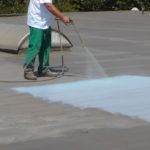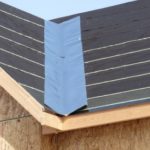Observing the main types of brick waterproofing and the ways of performing them.
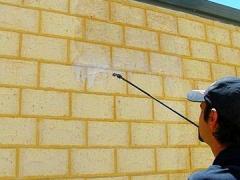 Exterior brick waterproofing is an effective protection of your house from moisture and dampness. Brick house always looks like a wall, but as safe it may seem is and as impregnable its appearance may look, as defenseless and helpless it may be facing its main enemy – water is able to penetrate even the best building material and lead to premature failure of the building. Outside brick walls waterproofing is a proven way to prevent the negative effects of water on the foundation and walls, troubles in the form of mold and mildew. It will also prove the belief that the house can remain dry and warm for long decades.
Exterior brick waterproofing is an effective protection of your house from moisture and dampness. Brick house always looks like a wall, but as safe it may seem is and as impregnable its appearance may look, as defenseless and helpless it may be facing its main enemy – water is able to penetrate even the best building material and lead to premature failure of the building. Outside brick walls waterproofing is a proven way to prevent the negative effects of water on the foundation and walls, troubles in the form of mold and mildew. It will also prove the belief that the house can remain dry and warm for long decades.
Of course, it is best to provide a moisture barrier performance during the complex of works during the construction period (outside the building and on the inside). However, constructed and operated buildings are also often subject of waterproofing. Let’s talk about the main types of brickwork waterproofing.
Also read: Types of waterproofing used at different stages of building
Moisture in the house: The origins of the problem
Apart from all the undoubted advantages of brick which is one of the most popular materials in the private houses construction, it has a significant drawback – it is porosity. Water easily penetrates the unprotected masonry at micro cracks and, as a result, the moisture can damage:
- foundation;
- basement;
- basement rooms;
- walls, including bearing ones
This leads to dampness, mold and fungus spreading; also it affects the health of residents of the house. Moisture usually comes from the ground water in case of close bedding and precipitation meltwater. It is necessary to protect not only the foundation of the house, because the above ground part of the house is not less vulnerable. In addition, salts contained in water accumulate and exert a negative effect – brick has a tendency to corrode, which leads to its destruction.
Waterproofing is also important for auxiliary buildings which are often built of brick:
- bath-houses;
- garages;
- outbuildings.
How to protect brick walls from moisture
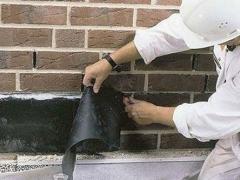 There are a number of ways to implement such a responsible set of works as waterproofing brick masonry. They are performed using the following key waterproofing technologies:
There are a number of ways to implement such a responsible set of works as waterproofing brick masonry. They are performed using the following key waterproofing technologies:
- painting waterproofing;
- pasting waterproofing;
- plastering;
- silicone waterproofing
You have to remember that penetrating waterproofing usually used for concrete structures is not suitable for protection brickwork.
Painting waterproofing
While performing painting method of brick waterproofing you should apply different mastic based on:
- bitumen with fillers;
- different sealers;
- synthetic resins.
The surface should be carefully cleaned beforehand to avoid gaps, ledges, rough. To achieve the perfect result can use a masonry primer. After it is completely dried, apply the necessary material, for example, sealer. Generally the work usually takes 2-3 hours (for the whole private house). The thickness of each layer is about 0,2 inch.
Pasting waterproofing
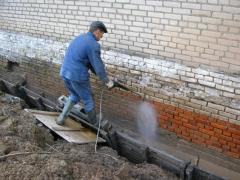 Pasting is performed with the use of such materials as:
Pasting is performed with the use of such materials as:
- roofing;
- insulation;
- brizol.
The surface is glued over with different bituminous mastics. The solid waterproofing coatings appear this way. In case of high groundwater it may be protected by clamping walls to avoid the contact with the soil.
Plastering waterproofing
It is based on a cement-sand mortar. The mixture usually consists of some penetrating materials and high-quality cement. It gives reliable protection against appearing and spreading of moisture.
More: Waterproofing cement: compound and technology of application
Silicone waterproofing
Silicone water repellent gives the solid protection from such environmental factors as snow, rain, dew point, temperature changes, frost, etc. Wet constructions damage the hydro insulation of the whole structure. This leads to increasing of costs of energy for home heating, the appearance of efflorescence and mold on the walls. After treatment the surface of building with silicone water repellent its hydro insulating properties improve, as well as its frost, brick, concrete slab or wooden planks, tiles and other building material is stronger and more durable.
Important!
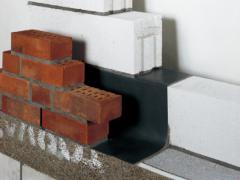 Preworking is an important stage of brick waterproofing process the whole life of your future waterproofing depends on. Thorough cleaning, alignment, eliminating grease and draining the surface are the works predetermining the protection against moisture.
Preworking is an important stage of brick waterproofing process the whole life of your future waterproofing depends on. Thorough cleaning, alignment, eliminating grease and draining the surface are the works predetermining the protection against moisture.
You should remember that your house can not be reliably protected from moisture if you have perform only brick walls waterproofing. Your work may be done in vain if you do not perform the foundation waterproofing. Foundation is the first structure part of your house to be protected from moisture danger.
We hope that this article was useful for you in case you are searching some common answers in the field of brick waterproofing. These methods are quite simple to be performed with your own hands.

